初中介词用法总结
- 格式:doc
- 大小:52.00 KB
- 文档页数:10
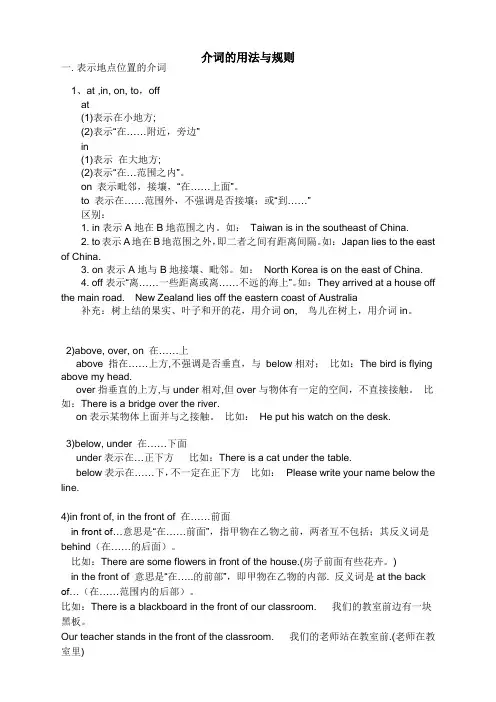
介词的用法与规则一. 表示地点位置的介词1、at ,in, on, to,offat(1)表示在小地方;(2)表示“在……附近,旁边”in(1)表示在大地方;(2)表示“在…范围之内”。
on 表示毗邻,接壤,“在……上面”。
to 表示在……范围外,不强调是否接壤;或“到……”区别:1. in表示A地在B地范围之内。
如:Taiwan is in the southeast of China.2. to表示A地在B地范围之外,即二者之间有距离间隔。
如:Japan lies to the east of China.3. on表示A地与B地接壤、毗邻。
如:North Korea is on the east of China.4. off表示“离……一些距离或离……不远的海上”。
如:They arrived at a house off the main road. New Zealand lies off the eastern coast of Australia补充:树上结的果实、叶子和开的花,用介词on, 鸟儿在树上,用介词in。
2)above, over, on 在……上above 指在……上方,不强调是否垂直,与below相对;比如:The bird is flying above my head.over指垂直的上方,与under相对,但over与物体有一定的空间,不直接接触。
比如:There is a bridge over the river.on表示某物体上面并与之接触。
比如:He put his watch on the desk.3)below, under 在……下面under表示在…正下方比如:There is a cat under the table.below表示在……下,不一定在正下方比如:Please write your name below the line.4)in front of, in the front of 在……前面in front of…意思是“在……前面”,指甲物在乙物之前,两者互不包括;其反义词是behind(在……的后面)。
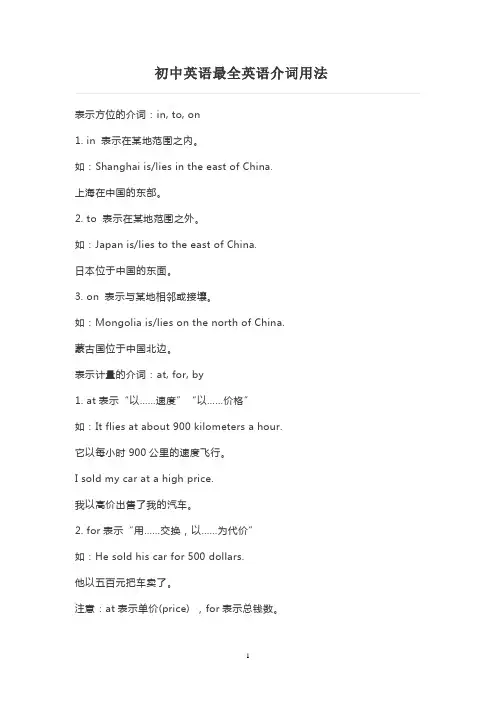
表示方位的介词:in, to, on1. in 表示在某地范围之内。
如:Shanghai is/lies in the east of China.上海在中国的东部。
2. to 表示在某地范围之外。
如:Japan is/lies to the east of China.日本位于中国的东面。
3. on 表示与某地相邻或接壤。
如:Mongolia is/lies on the north of China.蒙古国位于中国北边。
表示计量的介词:at, for, by1. at表示“以……速度”“以……价格”如:It flies at about 900 kilometers a hour.它以每小时900公里的速度飞行。
I sold my car at a high price.我以高价出售了我的汽车。
2. for表示“用……交换,以……为代价”如:He sold his car for 500 dollars.他以五百元把车卖了。
注意:at表示单价(price) ,for表示总钱数。
3. by表示“以……计”,后跟度量单位如:They paid him by the month.他们按月给他计酬。
Here eggs are sold by weight.在这里鸡蛋是按重量卖的。
表示材料的介词:of, from, in1. of成品仍可看出原料如:This box is made of paper.这个盒子是纸做的。
2. from成品已看不出原料如:Wine is made from grapes.葡萄酒是葡萄酿成的。
3. in 表示用某种材料或语言如:Please fill in the form in pencil first.请先用铅笔填写这个表格。
They talk in English.他们用英语交谈。
注意:in指用材料,不用冠词;而with指用工具,要用冠词。
如:draw in pencil/draw with a pencil表示工具或手段的介词:by, with, on1、by用某种方式,多用于交通如by bus乘公共汽车,by e-mail. 通过电子邮件。
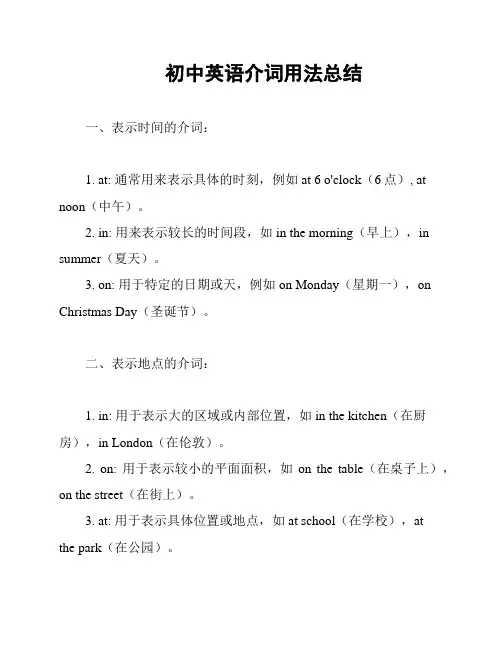
初中英语介词用法总结一、表示时间的介词:1. at: 通常用来表示具体的时刻,例如 at 6 o'clock(6点), at noon(中午)。
2. in: 用来表示较长的时间段,如 in the morning(早上),in summer(夏天)。
3. on: 用于特定的日期或天,例如 on Monday(星期一),on Christmas Day(圣诞节)。
二、表示地点的介词:1. in: 用于表示大的区域或内部位置,如 in the kitchen(在厨房),in London(在伦敦)。
2. on: 用于表示较小的平面面积,如on the table(在桌子上),on the street(在街上)。
3. at: 用于表示具体位置或地点,如 at school(在学校),atthe park(在公园)。
三、表示方式、方式、原因的介词:1. by: 表示通过某种方式或手段,如 by bus(乘公交车),by email(通过电子邮件)。
2. with: 表示伴随或使用某物,如with friends(和朋友一起),with a pen(用一支笔)。
3. for: 表示目的或原因,如 for fun(为了好玩),for the reason (因为...)。
四、表示动作方向的介词:1. to: 表示运动或行动的方向,如 go to school(去学校),send a letter to(寄一封信给)。
2. into: 表示进入某个内部空间,如 jump into the pool(跳进游泳池)。
五、表示关系和连接的介词:1. of: 表示所有关系,如 a photo of my family(我家的照片)。
2. with: 表示随同或具有某种关系,如 a girl with long hair(一位长发的女孩)。
3. to: 表示某种连接或关联,如 the key to the door(开门的钥匙)。
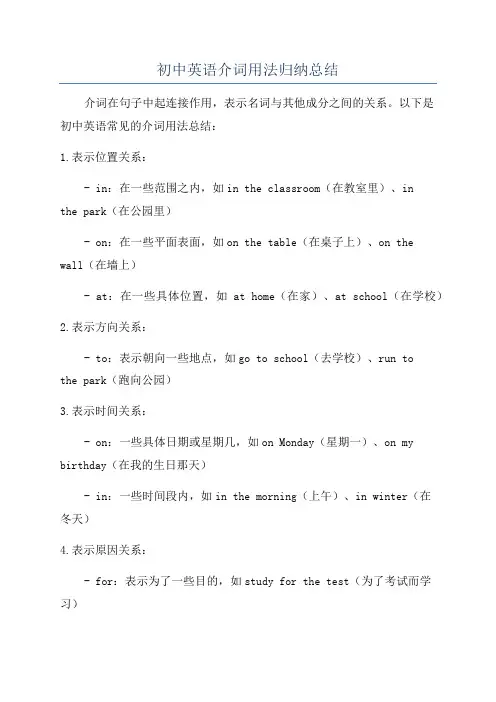
初中英语介词用法归纳总结介词在句子中起连接作用,表示名词与其他成分之间的关系。
以下是初中英语常见的介词用法总结:1.表示位置关系:- in:在一些范围之内,如in the classroom(在教室里)、inthe park(在公园里)- on:在一些平面表面,如on the table(在桌子上)、on thewall(在墙上)- at:在一些具体位置,如at home(在家)、at school(在学校)2.表示方向关系:- to:表示朝向一些地点,如go to school(去学校)、run tothe park(跑向公园)3.表示时间关系:- on:一些具体日期或星期几,如on Monday(星期一)、on my birthday(在我的生日那天)- in:一些时间段内,如in the morning(上午)、in winter(在冬天)4.表示原因关系:- for:表示为了一些目的,如study for the test(为了考试而学习)- because of:表示因为一些原因,如because of the rain(因为下雨)5.表示方式或手段:- by:通过其中一种方式或手段,如by bus(乘公交车)、by email(通过邮件)6.表示比较、对照关系:- than:与人或物进行比较,如I am taller than my brother(我比我兄弟高)7.表示从属关系:- of:表示所属关系,如the book of the teacher(老师的书)- to:表示归属关系,如a friend to me(对我来说的一个朋友)这些是初中英语中常见的介词用法,但还有其他一些特殊用法,需要根据具体语境来确定使用。
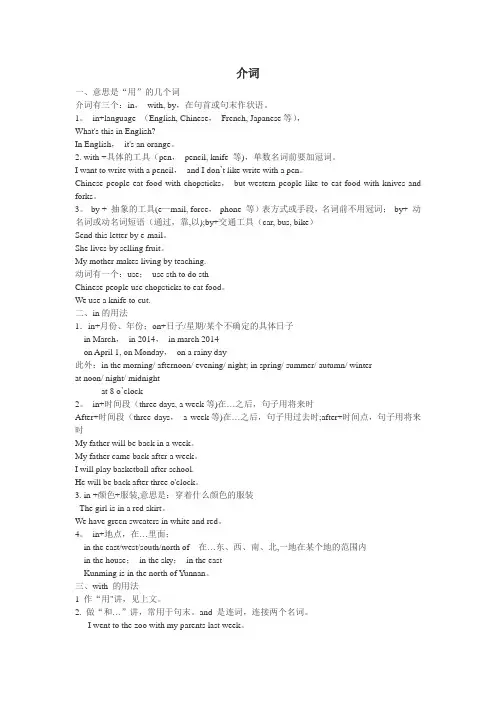
介词一、意思是“用”的几个词介词有三个:in,with, by,在句首或句末作状语。
1。
in+language (English, Chinese,French, Japanese等),What's this in English?In English,it's an orange。
2. with +具体的工具(pen,pencil, knife 等),单数名词前要加冠词。
I want to write with a pencil,and I don’t like write with a pen。
Chinese people eat food with chopsticks,but western people like to eat food with knives and forks。
3。
by + 抽象的工具(e—mail, force,phone 等)表方式或手段,名词前不用冠词;by+ 动名词或动名词短语(通过,靠,以);by+交通工具(car, bus, bike)Send this letter by e-mail。
She lives by selling fruit。
My mother makes living by teaching.动词有一个:use;use sth to do sthChinese people use chopsticks to eat food。
We use a knife to cut.二、in的用法1.in+月份、年份;on+日子/星期/某个不确定的具体日子in March,in 2014,in march 2014on April 1, on Monday,on a rainy day此外:in the morning/ afternoon/ evening/ night; in spring/ summer/ autumn/ winterat noon/ night/ midnightat 8 o’clock2。

初中英语知识点归纳介词的用法介词是连接词与词之间,短语与短语之间,在句中表示方向、关系、时间、原因等意义的词语。
在英语中,介词的用法非常丰富多样,掌握好介词的用法,对于学习英语有着重要的意义。
下面将对初中英语中常见的介词用法进行归纳介绍。
一、表示方向、位置和距离的介词1. 在(in):在某个地方或物体内部2. 在(on):在某个平面或表面上3. 在(at):在某个地点4. 在(over):位于之上,不接触5. 在(under):位于之下,不接触6. 在(between):在两个事物之间7. 在(behind):在某物之后8. 在(in front of):在某物之前9. 在(near):在附近10. 在(around):在周围二、表示时间的介词1. 在(at):在某个具体时间点2. 在(in):在某个时间段3. 在(on):在某个具体日期三、表示原因的介词1. 因为(of):表示原因、缘故2. 由于(because of):表示原因、由于四、表示目的、用途和方式的介词1. 为了(in order to):表示目的2. 以便(in order that):表示目的3. 用(with):表示使用的手段或工具4. 通过(by):表示方式、方法5. 以(for):表示目的五、表示比较的介词1. 比较起见(than):表示比较的对象2. 和(with):与某人或某物在一起六、其它常见的介词1. 关于(about):表示涉及某一话题2. 靠(by):表示接近某人或某物3. 经过(through):表示通过某地或某事4. 编写(at):表示在某地工作或活动5. 因(as):表示角色、身份6. 例如(for example):表示举例7. 包括(including):表示包含某物以上是初中英语中常见的介词用法的归纳总结。
熟练掌握这些介词的用法,对于构建正确的句子和语法结构非常重要。
希望能对你的学习有所帮助。
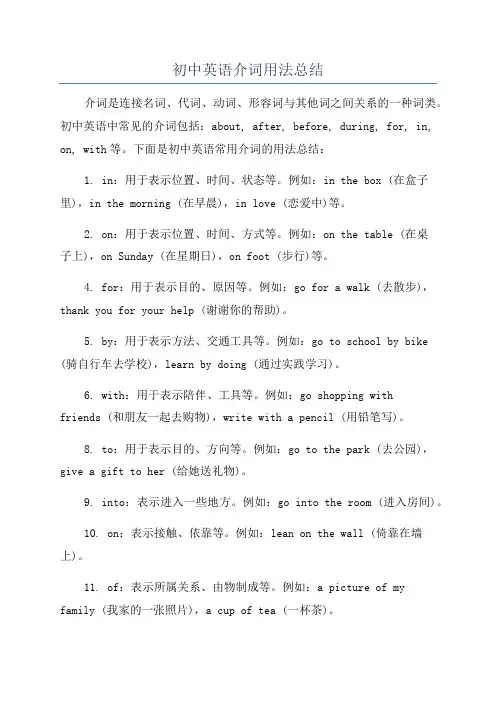
初中英语介词用法总结介词是连接名词、代词、动词、形容词与其他词之间关系的一种词类。
初中英语中常见的介词包括:about, after, before, during, for, in, on, with等。
下面是初中英语常用介词的用法总结:1. in:用于表示位置、时间、状态等。
例如:in the box (在盒子里),in the morning (在早晨),in love (恋爱中)等。
2. on:用于表示位置、时间、方式等。
例如:on the table (在桌子上),on Sunday (在星期日),on foot (步行)等。
4. for:用于表示目的、原因等。
例如:go for a walk (去散步),thank you for your help (谢谢你的帮助)。
5. by:用于表示方法、交通工具等。
例如:go to school by bike (骑自行车去学校),learn by doing (通过实践学习)。
6. with:用于表示陪伴、工具等。
例如:go shopping withfriends (和朋友一起去购物),write with a pencil (用铅笔写)。
8. to:用于表示目的、方向等。
例如:go to the park (去公园),give a gift to her (给她送礼物)。
9. into:表示进入一些地方。
例如:go into the room (进入房间)。
10. on:表示接触、依靠等。
例如:lean on the wall (倚靠在墙上)。
11. of:表示所属关系、由物制成等。
例如:a picture of myfamily (我家的一张照片),a cup of tea (一杯茶)。
12. with:表示伴随、具有。
例如:a girl with long hair (一个长发的女孩),a book with pictures (一本有图片的书)。

初中英语介词用法归纳整理初中英语介词的用法有很多,知识点也不少,想要学好初中英语介词的话,最好整理好初中英语介词知识点。
以下是店铺分享给大家的初中英语介词用法归纳,希望可以帮到你!初中英语介词用法归纳表示时间的介词at:用于表示时刻,时间的某一点。
on:用于星期,某天,某一天的上午,下午,晚上(指具体的某一天时,一律用onin:用于表示周,月,季节,年,泛指上午,下午,晚上before:在...之前after:在...之后by:在....前(时间)截止(到)...until(till):直到.....为止for:达...之久(表示过了多少时间)during:在....期间through:一直..(从开始到结束)from:从...起(时间)since:自从...以来(表示从以前某时一直到现在仍在继续)in:过...后(未来时间)within:不超过...的范围表示场所,方向的介词at :在某地点(表示比较狭窄的场所)in:在某地(表示比较宽敞的场所)on:在...上面,有接触面above:在...上方over:在...正上方,是under的反义词under:在..下面,在...之内below :在...下方(不一定是正下方)near:近的,不远的by:在...的旁边,比near的距离要近between:在两者之间among:在三者或者更多的之中around:环绕,在...的周围,在....的四周in front of:在...的前面behind:在...后边in:在..之内,用于表示静止的位置into:进入out of :和into一样,也表示有一定的运动方向along:沿着across:横过(平面物体)through:贯通,通过to :达到..地点(目的地)或方向for:表示目的,为了.....from:从...地点起其他介词with:和..在一起; 具有,带有; 用某种工具或方法in:表示用什么材料(例如:墨水,铅笔等)或用什么语言。
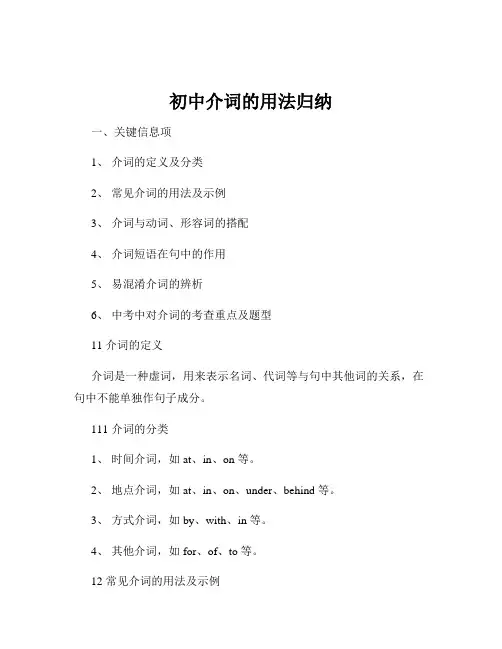
初中介词的用法归纳一、关键信息项1、介词的定义及分类2、常见介词的用法及示例3、介词与动词、形容词的搭配4、介词短语在句中的作用5、易混淆介词的辨析6、中考中对介词的考查重点及题型11 介词的定义介词是一种虚词,用来表示名词、代词等与句中其他词的关系,在句中不能单独作句子成分。
111 介词的分类1、时间介词,如 at、in、on 等。
2、地点介词,如 at、in、on、under、behind 等。
3、方式介词,如 by、with、in 等。
4、其他介词,如 for、of、to 等。
12 常见介词的用法及示例121 at 的用法1、表示在具体的时刻,如 at six o'clock。
2、表示在较小的地点,如 at the bus stop。
122 in 的用法1、表示在较长的时间段,如 in the morning。
2、表示在较大的地点,如 in Beijing。
123 on 的用法1、表示在具体的某一天,如 on Monday。
2、表示在物体的表面,如 on the table。
13 介词与动词、形容词的搭配131 与动词的搭配例如,look at(看)、listen to(听)、arrive in/at(到达)等。
132 与形容词的搭配例如,be interested in(对感兴趣)、be good at(擅长)等。
14 介词短语在句中的作用141 作定语如,The girl in red is my sister (in red 作定语修饰 girl)142 作状语如,He studies hard at night (at night 作状语)143 作表语如,He is in the classroom (in the classroom 作表语)15 易混淆介词的辨析151 in 和 onin 表示在里面,on 表示在上面。
152 at 和 inat 表示在较小的地点,in 表示在较大的地点。
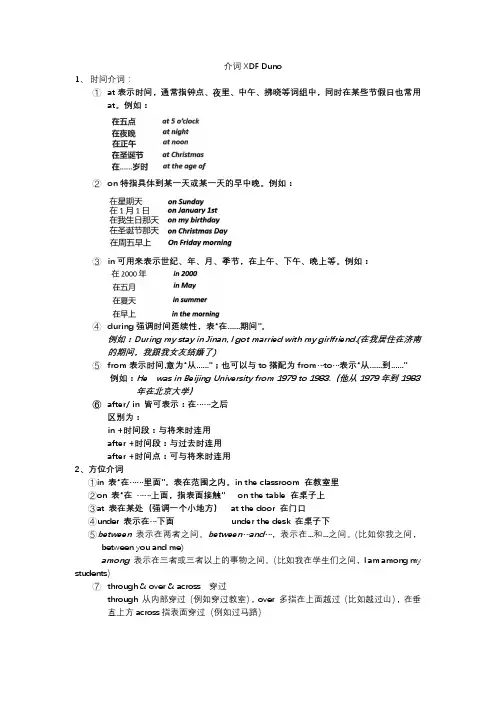
介词XDF Duno1、时间介词:①at表示时间,通常指钟点、夜里、中午、拂晓等词组中,同时在某些节假日也常用at。
例如:②on特指具体到某一天或某一天的早中晚。
例如:③in可用来表示世纪、年、月、季节,在上午、下午、晚上等。
例如:④during强调时间延续性,表“在......期间”。
例如:During my stay in Jinan, I got married with my girlfriend.(在我居住在济南的期间,我跟我女友结婚了)⑤from表示时间,意为“从......”;也可以与to搭配为from…to…表示“从......到......”例如:He was in Beijing University from 1979 to 1983.(他从1979年到1983 年在北京大学)⑥after/ in 皆可表示:在……之后区别为:in +时间段:与将来时连用after +时间段:与过去时连用after +时间点:可与将来时连用2、方位介词①in 表“在……里面”,表在范围之内。
in the classroom 在教室里②on 表“在……上面,指表面接触”on the table 在桌子上③at 表在某处(强调一个小地方)at the door 在门口④under 表示在…下面under the desk 在桌子下⑤between 表示在两者之间。
between…and…,表示在...和...之间。
(比如你我之间,between you and me)among 表示在三者或三者以上的事物之间。
(比如我在学生们之间,I am among my students)⑦through & over & across 穿过through 从内部穿过(例如穿过教室),over 多指在上面越过(比如越过山),在垂直上方across指表面穿过(例如过马路)2、方式介词①with “用”表示使用工具:with my phone表示使用某种器官:see with our eyes(用我们眼睛看)②in “用”表示使用某种语言:in English 用英语表示使用声音:in a high voice 使用高声表示穿某种颜色衣服:in white 穿白颜色的衣服③by表示乘坐交通工具后面直接加交通工具即可by bus乘公交。
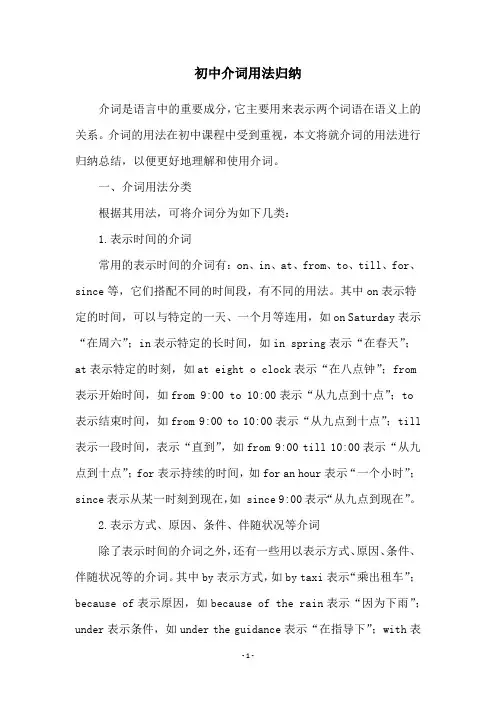
初中介词用法归纳介词是语言中的重要成分,它主要用来表示两个词语在语义上的关系。
介词的用法在初中课程中受到重视,本文将就介词的用法进行归纳总结,以便更好地理解和使用介词。
一、介词用法分类根据其用法,可将介词分为如下几类:1.表示时间的介词常用的表示时间的介词有:on、in、at、from、to、till、for、since等,它们搭配不同的时间段,有不同的用法。
其中on表示特定的时间,可以与特定的一天、一个月等连用,如on Saturday表示“在周六”;in表示特定的长时间,如in spring表示“在春天”;at表示特定的时刻,如at eight o clock表示“在八点钟”;from 表示开始时间,如from 9:00 to 10:00表示“从九点到十点”;to表示结束时间,如from 9:00 to 10:00表示“从九点到十点”;till 表示一段时间,表示“直到”,如from 9:00 till 10:00表示“从九点到十点”;for表示持续的时间,如for an hour表示“一个小时”;since表示从某一时刻到现在,如 since 9:00表示“从九点到现在”。
2.表示方式、原因、条件、伴随状况等介词除了表示时间的介词之外,还有一些用以表示方式、原因、条件、伴随状况等的介词。
其中by表示方式,如by taxi表示“乘出租车”;because of表示原因,如because of the rain表示“因为下雨”;under表示条件,如under the guidance表示“在指导下”;with表示伴随状况,如with a smile表示“微笑着”。
3.表示方向和位置的介词另外,介词还可以用来表示方向和位置,如on表示“位于”,如on the wall表示“位于墙上”;in表示“位于”,如in the box表示“位于盒子里”;to表示“向”,如to school表示“向学校”;from 表示“从”,如from school表示“从学校”;over表示“在…的上面”,如over the river表示“在河的上面”;under表示“在…的下面”,如under the bridge表示“在桥的下面”;beside表示“在…旁边”,如beside the lake表示“在湖旁边”。
初一英语常见介词用法归纳介词在英语中起到连接词的作用,连接名词、代词、动词、形容词或副词等成分。
在初中英语学习过程中,介词是一个非常重要的语法项目。
我们需要对初中英语中常见的介词用法进行归纳整理,以便更好地掌握这一部分知识。
一、介词的基本用法1. 表示位置:in, on, at- in: 在…里面(较大的范围)e.g. in the box- on:在…上面e.g. on the table- at:在…处e.g. at the bus stop4. 表示原因:because of, due to- because of: 由于e.g. He was late because of the heavy traffic.- due to: 由于e.g. The cancellation of the event was due to bad weather.5. 表示方式:by, with- by: 通过…手段e.g. by bus- with: 用…方式e.g. with a smile9. 表示所属:of- of: …的e.g. the hat of the boy2. look forward to: 期待e.g. I am looking forward to the summer vacation.5. be interested in: 对…感兴趣e.g. Amy is interested in learning Chinese.三、常见介词错误用法及纠正1. 错误用法:depend of正确用法:depend one.g. We depend on each other.通过以上的介词错误用法及纠正,我们可以更清晰地了解该如何正确使用这些介词。
四、综合练习通过上述的综合练习,可以帮助大家更好地掌握介词用法。
初中介词用法1.表示“标准或单位”的介词:at, for, by(1)at表示“以……速度”“以……价格”He drove at a speed of 80 miles an hour.他以每小时8英里的速度行驶。
I sold my car at a high price.我以高价出售了我的汽车。
(2)for用……交换I bought it for 20 dollars.买它花了我20美元。
How much for these apples?这些苹果多少钱?at与for都表示价格,但at表示“单价”,for表示总价,at后一般跟“price”这个词,而for后只能跟总钱数。
如:I bought it at a low price.我买它的价格很低。
I bought it at the price of $80 a pound.我以每磅80美元的价格买的它。
I sold it for $10.我10美元把它卖掉了。
(3)by以……计,后跟度量单位Gold is sold by the gram.金以克出售。
They paid him by the month.他们按月给他计酬。
2.表示“材料”的介词:of, from, in(1)of表示从成品仍可看出原料。
This box is made of paper.这个盒子是纸做的。
This salad is made of apples and strawberries.这种沙拉是由苹果和草莓做的。
(2)from表示从成品已看不出原料。
Bread is made from wheat.面包是小麦做的。
The lifeboat is made from some special material.这个救生艇是由某种特殊材料制成的。
(3)in用……材料。
常用write, speak, talk, answer等连用。
Please fill in the form in pencil first.请先用铅笔填写这个表格。
初中中的介词用法详解介词是一种连接词,在句子中起连接作用,用来表示人、事、物之间的关系。
它在语法中扮演着重要的角色。
在初中阶段,学生们需要掌握常见的介词及其用法,以正确地运用介词,表达清晰准确的意思。
下面将详细介绍初中中的介词用法。
一、介词的基本概念介词是一种虚词,它不能独立作句子的成分,必须与其他词语结合使用。
它可以用于表示时间、地点、方向、原因、目的、手段等关系。
二、表示时间的介词1. at:用于表示具体的某一点时间,比如at 7 o'clock、at noon。
2. on:用于表示某一天、某一日期,比如on Monday、on March 1st。
3. in:用于表示某一段时间、某一年份,例如in the morning、in 2022。
三、表示地点的介词1. in:用于表示大范围的地点,如in China、in the kitchen。
2. on:用于表示具体的平面或位置,如on the table、on the left。
3. at:用于表示具体的位置或地点,如at the bus stop、at the cinema。
四、表示方向的介词1. to:表示朝向某个地点或目的地,例如go to school、send the letter to her。
2. from:表示从某个地点或源头出发,例如come from Japan、receive a gift from my friend。
五、表示原因的介词1. because of:表示由于某个原因,如failed the exam because of laziness。
2. due to:表示由于某个原因产生的结果,例如missed the train due to the traffic jam。
六、表示目的或用途的介词1. for:用于表示目的或用途,例如study hard for a good future、buy flowers for my mother。
介词总结归纳初中介词是英语语法中的一个重要部分,用来表示名词、代词与其他词之间的关系。
在初中阶段,学生需要掌握并正确运用各种介词。
下面将对初中阶段常见的介词进行总结归纳。
一、表示位置或方向的介词:1. in:在某个范围、地点或建筑物内。
例:I am studying in the classroom.2. on:在某个平面或物体的表面。
例:The book is on the table.3. at:在某个特定的地点或事件上。
例:He is waiting at the bus stop.4. under:在某物的下面。
例:The cat is under the table.5. above:在某物的上面。
例:The bird is flying above the tree.6. behind:在某物的后面。
例:The car is parked behind the house.7. in front of:在某物的前面。
例:The children are playing in front of the school. 8. between:在两个物体或位置之间。
例:The river flows between the two mountains.9. among:在三个或三个以上的物体或位置之间。
例:He found his friends among the crowd.二、表示时间的介词:1. at:在特定的时间点。
例:The movie starts at 7 o'clock.2. on:在某一天、日期或节日。
例:We have a holiday on Sunday.3. in:在某个时间段或季节。
例:She was born in October.4. during:在某个时间段内。
例:I read a book during the summer vacation.5. for:表示持续时间。
初中英语介词用法总结介词(preposition):也叫前置词。
在英语里,它的搭配能力最强。
但不能单独做句子成分需要和名词或代词(或相当于名词的其他词类、短语及从句)构成介词短语,才能在句中充当成分。
介词是一种虚词,不能独立充当句子成分,需与动词、形容词和名词搭配,才能在句子中充当成分。
介词是用于名词或代词之前,表示词与词之间关系的词类,介词常与动词、形容词和名词搭配表示不同意义。
介词短语中介词后接名词、代词或可以替代名词的词(如:动名词v-ing).介词后的代词永远为宾格形式。
介词的种类:(1)简单介词:about, across, after, against, among, around, at, before, behind, below, beside,but, by, down, during, for, from, in, of, on, over, near, round, since, to, under,up, with等等。
(2)分解介词:inside, into, outside, throughout, upon, without, within(3)短语介词:according to, along with, apart from, because of, in front of, in spite of, insteadof, owing to, up to, with reguard to(4)分词介词:considering, reguarding, including, concerning介词短语:构成介词+名词We go to school from Monday to Saturday.介词+代词Could you look for it instead of me?介词+动名词XXX.介词+毗连代/副词I was thinking of how we could get there.介词+不定式/从句XXX it.介词的用法:一、介词to的常见用法1.动词+toa)动词+ toadjust to适应,attend to处理;照料,agree to附和,amount to加起来达…,XXX属于,drink to为…干杯,get to到达,XXX发生在某人身上,hold to紧握,lead to通向,XXX听,occur to想起,object to否决,point to指向,XXX回覆,refer to参考;指的是…;触及,reply to回覆,XXX负责,stick to坚持,turn to求助,write to给或人写信。
初中介词的用法初中英语中介词的用法主要有以下几种:1. 表示时间:in、on、at。
in表示某个时间段,如“in the morning”(早上),“in the afternoon”(下午)。
on表示某个具体时间,如“on Sunday”(在星期天),“on June 12th”(在6月12日)。
at表示某个具体的时间点,如“at 3 o'clock”(在3点钟)。
2. 表示地点:in、on、at。
in表示在某个空间内部,如“in the room”(在房间里)。
on表示在某个物体的表面,如“on the table”(在桌子上)。
at表示在某个位置或目标,如“at the school”(在学校)。
3. 表示方式:by、with、in。
by表示通过某种方式或手段,如“by bus”(乘公交车)。
with表示使用某种工具或伴随某种状态,如“with a pen”(用笔)。
in表示以某种语言或方式,如“in English”(用英语)。
4. 表示比较:than、as、like。
than用于比较级,表示比较关系,如“she is taller than him”(她比他高)。
as用于同级比较,表示“和……一样”,如“she is as tall as him”(她和一样高)。
like用于比喻或类比,表示相似性,如“she is like a tall tree”(她像一棵高大的树)。
5. 表示原因:because、since、for。
because表示直接原因,强调主观动机或解释,如“I am late because I overslept”(我迟到了因为我睡过头了)。
since表示已知事实作为推理依据,强调客观原因,如“Si nce you are not available, I will do it myself”(既然你不能来,我自己来)。
for表示原因或目的,强调行为的目的或结果,如“I bought a book for my sister's birthday gift”(我买了一本书作为我妹妹的生日礼物)。
介词英文缩写是prep.是英文preposition的缩写1.表示地点位置的介词1)at ,in, on, to,forat (1)表示在小地方; (2)表示“在……附近,旁边”in (1)表示在大地方; (2)表示“在…范围之内”。
on 表示毗邻,接壤,“在……上面”。
to 表示在……范围外,不强调是否接壤;或“到……”2)above, over, on 在……上above 指在……上方,不强调是否垂直,与below相对;over指垂直的上方,与under相对,但over与物体有一定的空间,不直接接触。
on表示某物体上面并与之接触。
The bird is flying above my head.There is a bridge over the river.He put his watch on the desk.3)below, under 在……下面under表示在…正下方below表示在……下,不一定在正下方There is a cat under the table.Please write your name below the line.4)in front [frant]of, in the front of在……前面in front of…意思是“在……前面”,指甲物在乙物之前,两者互不包括;其反义词是behind(在……的后面)。
There are some flowers in front of the house.(房子前面有些花卉。
)in the front of 意思是“在…..的前部”,即甲物在乙物的内部.反义词是at the b ack of…(在……范围内的后部)。
There is a blackboard in the front of our classroom.我们的教室前边有一块黑板。
Our teacher stands in the front of the classroom.我们的老师站在教室前.(老师在教室里)5)beside,behindbeside 表示在……旁边behind 表示在……后面2.表示时间的介词1)in , on,at 在……时in表示较长时间,如世纪、朝代、时代、年、季节、月及一般(非特指)的早、中、晚等。
如in the 20th century, in the 1950s, in 1989, in summer, in January, in the morning, in one’s life , in one’s thirties等。
on表示具体某一天及其早、中、晚。
如on May 1st, on Monday, on New Year’s Day, on a col d night in Janua ry, on a fine morning, on Sunday afternoon等。
at表示某一时刻或较短暂的时间,或泛指圣诞节,复活节等。
如at 3:20, at this time of year, at the beginning of, at the end of …, at t he age of …, at Christmas,at night, at noon, at this moment等。
注意:在last, next, this, that, some, every 等词之前一律不用介词。
如:We meet every day.2)in, after 在……之后“in +段时间”表示将来的一段时间以后;“after+段时间”表示过去的一段时间以后;“after+将来的时间点”表示将来的某一时刻以后。
3)from, since 自从……from仅说明什么时候开始,不说明某动作或情况持续多久;since表示某动作或情况持续至说话时刻,通常与完成时连用。
since表示"自(某具体时间)以来",常用作完成时态谓语的时间状语。
since liberation(1980)自从解放(1980年)以来They have been close fri ends since childhood.他们从小就是好朋友。
(1)since the war是指"自从战争结束以来",若指"自从战争开始以来",须说"sincethe beginning of the war"。
(2)不要将since与after混淆。
比较:He has worked here since 1965.(指一段时间,强调时间段)自从1 965年以来,他一直在这儿工作。
He began to work here after 1965.(指一点时间,强调时间点)从1965年以后,他开始在这儿工作。
4)after, behind 在……之后after主要用于表示时间;behind主要用于表示位置。
时间名词前介词用法口诀年前周前要用in具体日子要用on遇到几号也用on上午下午得是in要说某日上下午用on换in记清楚午夜黄昏用at黎明用它也不错at用在时分前说“差”可要用上to说"过''要用past3.表示运动方向的介词:across, through 通过,穿过across表示横过,即从物体表面通过,与on有关,为二维through穿过,即从物体内部穿过,与in有关,为三维。
4.表示“在……之间”的介词:表示“在……之间”的介词在英语中属于方位介词,如in front of ,behind ,on,in,near,under,upbetween, amongbetween指在两个人或两个事物之间;among指在三个或三个以上的人或事物之间。
5.表示其他意义的介词1)on ,about 关于on 表示这本书,这篇文章或演说是严肃的,或学术性的,可供专门研究这一问题的人阅读;about表示内容较为普通,不那么正式。
2)by, with, in 表示方法、手段、工具by 以……方法、手段或泛指某种交通工具;with 表示用…工具、手段,一般接具体的工具和手段;in 表示用…方式,用…语言(语调、笔墨、颜色)等;3)except, besides 除了except 除……之外,不包括在内;besides 除……之外,包括在内。
Except for Mr. Wang, we went to see the film.(王先生没去)Besides Mr. Wang, we also went to see the film.(王先生也去了)三.巩固练习1. Taiwan is _______ the southeast of China.(in, on, to)2. Go ____on_____ the bridge ___to______ the river, you’ll find the shop.(across, through; over, above)3. I go to school ______at____7:30 every morning.(in, on, at)4. He would like to meet her ______at____8:00 and 9:00 tomorrow morni ng.(between, among )5. The Greens have lived in China _____for___ three years.(in, for, afte r)6. We go to school every day ___on_____ Saturday and Sunday.(except, besides)7. He wrote the letter _________ ink.(by, with ,in)8. She returned to her country _____for____five years.(in, after, for)9. There is a big tree _________ our classroom.(after, behind)10. I usually go to work _________ bike.(by, on, with)1. There’s something _______ her that I really don’t l ike.A. withB. forC. toD. about2. I was angry _______ him for keeping me waiting.A. withB. toC. aboutD. on3. _______ going to French evening classes twice a week she does yoga on Wednesdays.A. Because ofB. ExceptC. BesidesD. But for4. _______ cooking, writing and running the farm, she was very busy.A. AmongB. BetweenC. OverD. As5. _______ one old lady, the bus was empty.A. ExceptB. Except forC. ButD. Besides6. They promise that the work would all be finished _______ next week.A. untilB. inC. byD. to7. We didn’t live together. We kept in touch _______ writing often.A. withB. ofC. onD. by8. It was very kind of her. She insisted _______ her car to us.A. to lendB. lendingC. on lendingD. in lending9. We’ve talked a lot _______ cars. What about trains?A. ofB. withC. aboutD. in10. “How long have you been here?” “_______ the end of last month.”A. InB. ByC. AtD. Since11. The chemistry teacher required the students _______ more attention _______ the lab clean.A. to pay, to keepB. to paying, to keepingC. to pay, to keepingD. payi ng, keeping12. “Is your car equal _______ hers in speed?” “No, mine is faster. But my old one equals _______ hers in speed."A. to, toB. \, \C. to, \D. \, to13. This exam is very important for her. She won’t go home ______ the exam.A. until afterB. after untilC. untilD. from14. This suit fits me well _______ the trousers are too long.A. onlyB. except forC. except thatD. except15. After a quick dinner, they set off ______ car and made ______ the n earest town.A. by, toB. in, toC. by, forD. in, for看似相同,但意义有别的词组英语中有一些介词词组和动词词组,它们从形式上看似乎基本相同,但在意义上却截然不同。